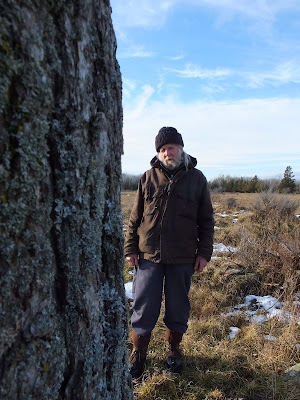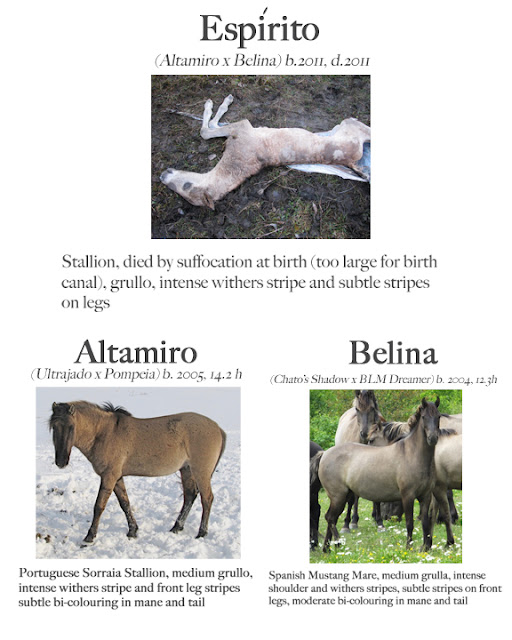A couple weeks ago I received a request from a biology student at McGill University who is involved with a research project on striping patterns in horses, asking for images, notes, stats, etc. on what we have experienced here at Ravenseyrie.
This request provided me with the stimulus I needed to finally put together more cohesively the results of the breeding that took place at Ravenseyrie. From 2008 to 2013 twenty foals were born. While I have documented quite extensively within this blog the births of these foals, a summary of that information, until now, has not been gathered in one place.
This blog entry first will feature an informational image for each offspring incorporating photos and descriptions. Each offspring is being presented in order by date of birth.
This blog entry will then offer up photos that display the variety of primitive markings that have been expressed in the wild-coat colour of our horses, all which are varying shades of grulla (rato in Portuguese) also often referred to as "mouse dun". This colour alters in appearance depending on the season and the light.
Animado was exported to the U.S.A. in 2011.
Fada remains with us and lives on the Twinravens range where we keep our band of mares on the southeast of Manitoulin Island, an hour's drive from Ravenseyrie.
Interessado was (regrettably) castrated in 2012. He remains with us at Ravenseyrie, living with the bachelor band.
Firstborn for this year was
Encantara:
Encantara was exported to the U.S.A. in 2011 and more recently was exported to Mexico
Next up is Silvestre:
Silvestre was (regrettably) castrated in 2012 and remains with us at Ravenseyrie, living with the bachelor band.
Next up is Segura:
Segura was exported to the U.S.A. in 2011.
Births in 2010
Firstborn for this year was Pinoteia:
Pinoteia remains with us and lives on the Twinravens range where we keep our band of mares on the southeast of Manitoulin Island, an hour's drive from Ravenseyrie.
Next up is Tocara:
Tocara was exported to Austria in 2012 and later exported to Portugal where she presently is part of a conservation effort in the northeastern region of the country.
Next up is Levada:
Levada was exported to Austria in 2012 and later to Portugal and this year moved across the border to Spain where she is part of a conservation project.
Births in 2011
Firstborn for this year was Esperanda:
Esperanda remains with us and lives on the Twinravens range where we keep our band of mares on the southeast of Manitoulin Island, an hour's drive from Ravenseyrie.
Next up is Altavida:
Altavida remains with us and lives on the Twinravens range where we keep our band of mares on the southeast of Manitoulin Island, an hour's drive from Ravenseyrie.
Next up is Espìrito:
Espìrito is the only foal born at Ravenseyrie that did not survive - he was too large and died during birth.
Next up is Legado:
Legado remains with us at Ravenseyrie and lives with the bachelor band.
Next up is Destemido:
Destemido remains with us at Ravenseyrie and lives in a pasture separate from the other bachelors.
Births in 2012
Firstborn in this year was Gosto:
Gosto left Ravenseyrie in the autumn of 2020 and presently resides in southern Ontario.
Next up is Fidalgo:
Fidalgo remains with us at Ravenseyrie and lives among the bachelor band.
Next up is Sedutor:
Sedutor remains with us at Ravenseyrie and lives among the bachelor band.
Next up is Capaz:
Capaz remains with us at Ravenseyrie and lives among the bachelor band.
Births in 2013
Firstborn in this year was Ousado:
Ousado remains with us at Ravenseyrie and lives among the bachelor band.
Next up is Rija:
Rija remains with us and lives on the Twinravens range where we keep our band of mares on the southeast of Manitoulin Island, an hour's drive from Ravenseyrie.
 |
| Ravenseyrie Sorraia Mustang Preserve, Manitoulin Island |
Having made a significant contribution to the conservation of the endangered Sorraia and Sorraia Mustang horse the Ravenseyrie Sorraia Mustang Preserve in 2013 ended the breeding phase of our mandate and shifted to strictly safeguarding the remaining horses in our stewardship.
 |
Light grullo/Fidalgo, medium grullo/Altamiro
|
All Ravenseyrie horses display one or more phenotypic elements (so-called primitive markings) characteristic of dun wild-type hair coat:
--dorsal stripe
--traverse stripes on legs
--bilateral stripes on withers, shoulders, neck
--bi-coloured ears
--bi-coloured mane and tail
--dark face mask
--dark bilateral spot on cheeks
--light vertical line up the back of legs
--traverse "fishbone" stripes along dorsal stripe
 |
| Subtle neck stripes/Bella |
 |
| Subtle neck stripes/Bella |
 |
| Subtle leg stripes and light vertical line/Bella |
 |
| Subtle leg stripes and light vertical line/Bella |
 |
| Dark spot on cheek/Zorita |
 |
Medium grulla standing behind light grulla,
dorsal stripes, withers and neck stripes, dark face mask
bi-coloured ears/Belina |
 |
| Subtle stripes on hocks/Ciente |
 |
| Intense stripes on front legs/Ciente |
 |
Intense stripes on front legs/Ciente
|
 |
| Subtle transverse "fishbone" stripes on dorsal stripe/Bella |
 |
| Medium grullo, winter pelage/Altamiro |
 |
| Medium grullo, late spring pelage/Altamiro |
 |
| Subtle withers and neck stripes/Bella |
 |
| Medium grulla, bi-colouring in ears and mane and tail/Bella |
 |
Light grullo/Animado(front) with (behind left)
medium grulla, dark face mask/Bella |
 |
| Light grulla, intense leg stripes and bi-coloured mane/Animado |
 |
| Medium grullo, bi-coloured ears and mane/Altamiro |
 |
Dark grullo (Centre) neck and withers stripe,
bi-coloured ears/Sedutor |
 |
| Medium grulla, bi-coloured mane |
 |
| Very light grulla, bi-coloured mane |
 |
| Intense wrinkles in neck hide/Altamiro |
 |
| Intense wrinkles in neck hide/Legado |
 |
| Intense neck and withers stripes/Encantara |
 |
| Medium grulla bi-coloured ears and mane/Ciente |
 |
Leg stripes on Animado (left) and Bella, his dam
|
 |
| Newborn, pseudo-stripes from compressed hair/Interessado |
 |
| Newborn, pseudo-stripes from compressed hair/Interessado |
 |
Intense leg, neck and withers stripes, compressed
hair pseudo stripes/Sedutor |
A summary of the horses in the Ravenseyrie Sorraia Mustang Preserve conservation effort:
Foundation Herd
Bella - mare, med. grulla, Spanish Mustang
Belina - mare, med. Spanish Mustang x BLM Mustang
Ciente - mare, med. grulla, Kiger Mustang
Zorita - mare, silver grulla, Sorraia x Sulphur Mustang
Altamiro - stallion, med. grullo, reg. Portuguese Sorraia
Offspring, first generation
2008
Animado, stallion, light grullo
Fada, mare, black grulla
Interessado, gelding, black grullo
2009
Encantara, mare, medium grulla
Silvestre, gelding, medium grullo
Segura, mare, very light grulla
2010
Pinoteia, mare, light grulla
Tocara, mare, med. grulla
Levada, mare, med. grulla
2011
Esperanda, mare, med. grulla
Altavida, mare, light grulla
Espirito, stallion, died at birth
Legado, stallion, very light grullo
2012
Gosto, stallion, dark grullo
Fidalgo, stallion, light grullo
Sedutor, stallion, dark grullo
2013
Ousado, stallion, light grullo
Rija, mare, light grulla
Offspring/Second Generation
2011
Destemido, stallion, med. grullo
2012
Capaz, stallion, light grullo
 |
| Pinoteia with her foal, Capaz on the Ravenseyrie beach, Manitoulin Island |
Over the years, I have done a fair bit of research on Sorraias, Sorraia Mustangs, Pleistocene horses, Pzewalski's Horse, the Tarpan and wild-type coat colour and primitive markings. I have written layman's articles within this blog regarding these subjects, some of which I am providing links to below. New discoveries regarding wild-type coat colour and the dun gene have been made since those earlier days when I was studying and writing about such things - I am providing links to those scientific research articles as well. (Clicking on each article's title should open up the link in a new window.)
 |
| The Family Band, Ravenseyrie beach 2008, Manitoulin Island |






































































